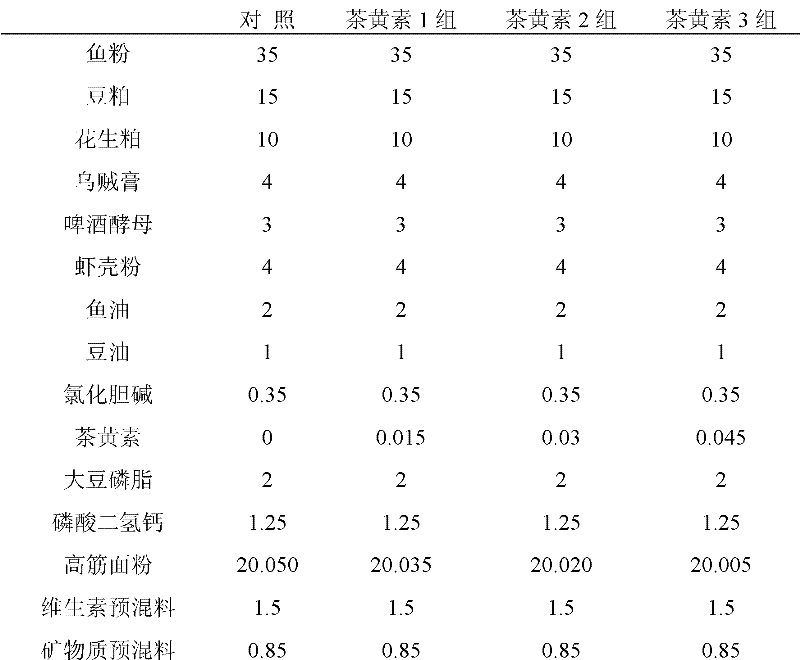Application of theaflavin as feed additive and corresponding feed
A feed additive, theaflavin technology, applied in the direction of animal feed, animal feed, application, etc., can solve the problems of feed rancidity, reduced palatability, toxic and side effects, etc., to promote weight gain, avoid drug residues, and avoid toxic and side effects. Effect
- Summary
- Abstract
- Description
- Claims
- Application Information
AI Technical Summary
Problems solved by technology
Method used
Image
Examples
Embodiment 1
[0033] Embodiment 1: Feed preparation method using theaflavin as a feed additive.
[0034] The raw materials of the formula shown in Table 1 are crushed through 60 meshes, and trace ingredients such as theaflavin and choline chloride are added step by step, mixed with large raw materials evenly, and made by SLX-80 extrusion machine Feeds with a diameter of 1.2mm were dried and cooled at 45°C and put into sealed bags and stored in a -15°C refrigerator until use. And the formula is prepared as the control feed shown in Table 1 in the same way.
[0035] Table 1 Test feed formula and nutrient composition (dry matter, %)
[0036]
[0037]
[0038] In the above feed formula, fishmeal and soybean meal are the main protein sources, fish oil and soybean oil are the main fat sources, and high-gluten flour is the main sugar source.
[0039] Among them, 1000g vitamin premix includes: vitamin A, 250000IU; vitamin D, 120000IU; vitamin K3, 500mg; vitamin E, 3600mg; vitamin B1, 550mg;...
Embodiment 2
[0041] Example 2: Effects of theaflavins on weight gain rate and specific growth rate of Litopenaeus vannamei
[0042] 1. Test method
[0043] 1.1 Feeding management
[0044] The breeding experiment was carried out in the indoor aquarium breeding system of Nan'ao Linhai Experimental Station of Shantou University. The experimental shrimps were purchased from a fine-bred shrimp nursery in Shantou City. They were first domesticated in the aquarium for 2 weeks, and then the healthy and healthy Litopenaeus vannamei with an initial average weight of 0.1±0.05g / tail were randomly divided into boxes and carried out. Breeding test.
[0045] One group is the control group, and the three groups are the test groups. Each group has three parallels, and each parallel has 50 tails. The control group was fed with basic feed, and the test group was fed with feed containing 0.015%, 0.03% and 0.045% theaflavin respectively. The breeding test was carried out for two months. Except for changing...
Embodiment 3
[0061] Example 3: Effects of theaflavins on main components of whole shrimp and muscle of Litopenaeus vannamei
[0062] 1. Test method
[0063] 1.1 feeding management: same as embodiment 2
[0064] 1.2 Test method
[0065] Accurately measure the feeding amount every day, collect hepatopancreas and muscle samples every 20 days, and take three samples in total. Blood is collected once after the test is over. crude fat. Stop feeding for 24 hours before each sampling, randomly select about 10 shrimps for each repetition, and use a sterile 1mL syringe to insert the blood from the shrimp head behind the carapace to collect blood, put it in an Eppenddorf centrifuge tube, and let it stand overnight at 4°C. Then centrifuge at 3000r / min for 10min, take the supernatant as the serum to be tested, and store it frozen for later use. After taking out the hepatopancreas and muscle, put it into an Eppenddorf centrifuge tube and store it in a -80°C refrigerator.
[0066] Homogenate preparat...
PUM
 Login to View More
Login to View More Abstract
Description
Claims
Application Information
 Login to View More
Login to View More - R&D
- Intellectual Property
- Life Sciences
- Materials
- Tech Scout
- Unparalleled Data Quality
- Higher Quality Content
- 60% Fewer Hallucinations
Browse by: Latest US Patents, China's latest patents, Technical Efficacy Thesaurus, Application Domain, Technology Topic, Popular Technical Reports.
© 2025 PatSnap. All rights reserved.Legal|Privacy policy|Modern Slavery Act Transparency Statement|Sitemap|About US| Contact US: help@patsnap.com



